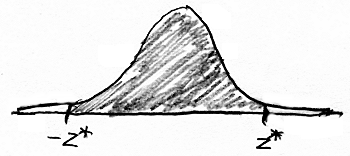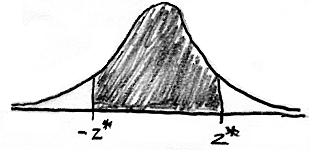Workshop Statistics: Discovery with Data, Second
Edition
Topic 19: Confidence Intervals I: Proportions
Activity 19-1: Penny Spinning
(a) pennies
(b) categorical
(c) Answers will vary from class to class.
(d) This proportion is a statistic, with the symbol  .
.
(e) no
(f) yes
(g)  , the
proportion of the sample
, the
proportion of the sample
(h)-(i) Answers will vary from class to class.
(j) no
Activity 19-2: Critical Values
(a)
(b) .99
(c) 2.33
(d, a)
(d, b) .975
(d, c) 1.96
Activity 19-3: Penny Spinning (cont.)
(a) Answers will vary from class to class.
(b) no
(c)-(d) Answers will vary from class to class but to find the width,
subtract the smaller endpoint from the larger endpoint.
(e) Since we add and subtract z*sqrt( (1-
(1- )/n)
from
)/n)
from  in forming
the interval, the quantity z*sqrt(
in forming
the interval, the quantity z*sqrt( (1-
(1- )/n)
is already the half-width.
)/n)
is already the half-width.
(f) The sample must be a simple random sample from the population of
interest, and the sample size must be large relative to the value of the
sample proportion (checked by calculating n >10
and n(1-
>10
and n(1- )>10)
)>10)
Activity 19-4: Halloween Practices and Beliefs (cont.)
(a) statistic
(b) categorical
(c) (.661, .718)
(d) The student's axis should have the region from approximately .661
to .718 shaded.
(e) Width: .057; Half-width: .0285
(f) Interval: (.282, .339); Width: .057; Half-width: .0285
(g) These half-widths are the same, but the intervals are not the same.
They are related because the sum of the lower value of one interval with
the upper value of the other interval should equal 1, i.e., subtract the
endpoints of the interval from 1. Often it will equal .999, because
of error due to rounding.
(h) Answers will vary from student to student.
(i) Interval: (.652, .727); Width: .075; Half-width: .0375
(j) The width of the 99% confidence interval is greater than the width
of the 95% confidence interval by .018. The midpoints, however, are
the same: .69.
(k) (.183, .256)
(l) Answers will vary from student to student.
(m) Interval: (.194, .245); Midpoint: .22; Half-width:
.0255; The midpoint is the same, but the width is narrower.
Activity 19-5: Reese's Pieces (cont.)
Students' answers to (a)-(c) may differ since the
data are chosen randomly. These are meant to be sample answers.
Note, answers (b)-(g) below, are the answers
to (a)-(f) in the Calculator version.
(a) Click here
for sample results.
(b) 186 of the 200 intervals captured .45.
(c) .32, .293, .32, .587, .587, .60, .573, .60, .623, .333, .333, .333,
.32, .293
(note, these are all on the extreme small end or the extreme high end)
(d) no
(e) When a large number of samples are taken, about 95% of the intervals
will contain the actual value of the population proportion.
Students' counts in (f)-(g) may differ since
the data are chosen randomly. These are meant to be sample answers.
(f) 195; 98%; This is reasonably close to the percentage
from (a). Changing the sample size does not change the coverage proportion.
However, the intervals are now more narrow.
(g) 159; 80%; This is not reasonably close to the percentage
from (a). The intervals are narrower so fewer of them capture q.
Activity 19-6: Literary Digest Pol (cont.)
(a) (.569, .571)
(b) The sampling method was biased so we can't expect these calculations
to be accurate.

